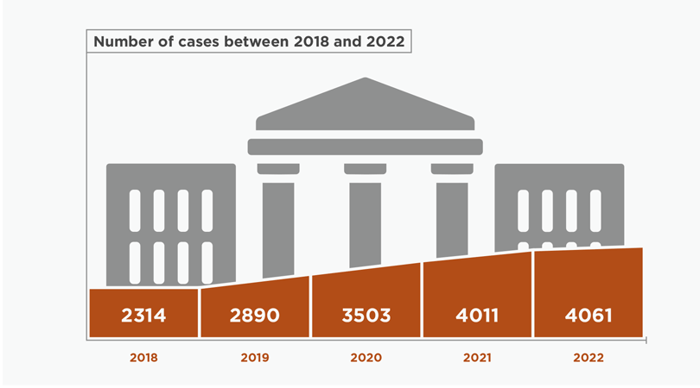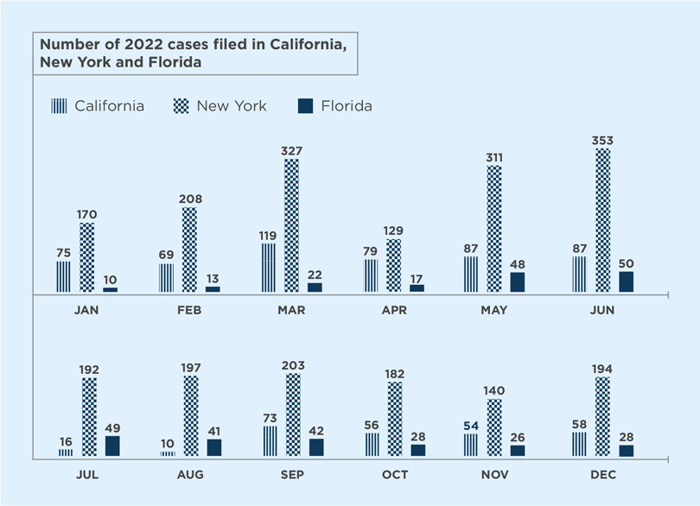UsableNet has now been tracking digital accessibility lawsuits for five years. When we first reported filings in 2018- cases had risen 181% from the previous year. We knew ADA claims had exploded but couldn't predict what might happen next.
Critical cases for ADA websites were battling in courts, Gil v. Winn-Dixie and Robles v. Domino's Pizza. To advise our customers, hundreds of businesses with digital assets like websites and apps, we started to mine the data*. We looked not just at numbers but for trends that offered practical advice.
After five years, I will reflect on and use our 2022 end-of-year report to help tell a story about the booming legal landscape for ADA-based app and web accessibility lawsuits and how we got here.
The lawsuit numbers tell only a piece of the story

In the last five years, we counted more than 16,000 digital accessibility claims. That's a significant number. This area of private litigation has been one of the fastest growing. These numbers are only ADA claims filed at the federal or state level and do not include pre-lawsuit legal actions, like demand letters.
In many cases, plaintiff law firms send demand letters on their client's behalf before filing an ADA lawsuit. The business defense attorneys I've spoken with are as busy counseling clients who have received demand letters as they are with clients who have received lawsuits.
I estimate that the total number of both ADA lawsuits and demand letters could be around over 50,000, three times more than filed cases that are trackable.
This year we will see over 4000 lawsuits, and from our knowledge, demand letters are filed in the same volume as they were in 2021.
The US Department of Justice (DOJ) helped get us here. Then they helped to make it worse.
For over 20 years, the DOJ has stated that websites are subject to the ADA. Yet, they have never specified what makes a website accessible. Because of this lack of clarity, digital accessibility lawsuits are a booming business for plaintiff law firms.
A typical claim is that a company's website is inaccessible to a person with a disability in violation of the ADA and equivalent state laws. (We've found that a person with a visual disability who uses a screen reader is the most common plaintiff). The ADA does not require that the plaintiff notify the defending company before filing a lawsuit. So, these lawsuits can feel out of the blue to businesses unaware that their websites are inaccessible.
After a business receives a lawsuit, they have a choice. They can settle and remedy the website, or if they believe their website is compliant with the ADA, they may ask counsel about fighting the case. Fighting an ADA lawsuit case can be an uphill battle. Domino's famously fought an ADA lawsuit for its mobile app and website, spending six years to finally settle after losing its case and thousands upon thousands of dollars.
Our data estimates that 95% of companies sued will settle instead of fighting this case. Such a high settlement rate is likely because it can cost companies significant legal fees to get to a trial. In most cases, website remediation is indeed necessary. Plaintiff attorneys know it is an uphill battle for companies to defend against lawsuits so they will push the defendants for settlements for tens of thousands of dollars.
On the DOJ side, they re-stated their position this year with their new guidance. The DOJ reaffirms that they believe the ADA covers websites but does not define what is accessible under the ADA. Therefore, the DOJ seems to have emboldened the plaintiff bar to increase its filing volume.
Lawsuits are many, but plaintiffs are few
These 16,000 lawsuits over the last five years are not 16,000 individuals who have struggled with a website and found a lawyer to help remedy the website. We often see "serial plaintiffs." Serial plaintiffs regularly sue companies in one industry or part of the country for web accessibility in a wave. For example, this year, the plaintiff Gomez sparked an outcry when he sued about four dozen Napa country wineries for web accessibility.
Yet, we often see these patterns in our analysis of ADA digital lawsuits. Serial plaintiffs like Gomez and the firms that represent them have a process to find companies and file suits in such high volumes. And, according to defense law firms, it's not uncommon to see templated demand letters.

The top individual plaintiffs and plaintiff firms have filed over 10,000 lawsuits in the last five years. In addition, other plaintiff law firms have taken notice. This year we have some new additions to our leaderboard for firms with the most lawsuits.
Key states and critical industries
Over the last five years, we've monitored the states with the most filings and when court decisions caused spikes in litigation. We reported when industries most impacted by court decisions fluctuated, such as when healthcare websites received more web accessibility lawsuits after covid.
So, let's look at the newest data and talk about the states with the most lawsuits and the industries most likely to receive cases.

New York, Florida, and California have gotten the lion's share of lawsuits this year and every year since 2018. And, while they aren't there yet, Pennsylvania and Massachusetts get honorable mentions for some emerging lawsuit activity. The most active plaintiff firms are in these states, and the courts empathize with the plaintiffs.
If your physical locations are not in one of the key three states, you should still check that your website is accessible, not just because it's good business sense. In five years, we've seen businesses of all sizes across the country receive digital accessibility lawsuits. People nationwide, including New York, California, and Florida customers, can generally do business with you if you have a website. If this is true, they can file claims against you in Florida, New York, or California courts.

On the industry side, eCommerce is the number one target, with 77% of digital accessibility cases against the industry. Just this year, just over 3,000 of all lawsuits targeted eCommerce.
Almost all top 500 eCommerce companies have received at least one, if not multiple, lawsuits over the past five years. For the plaintiffs, the sheer volume of retail websites makes it easy to scale finding, testing, and filing lawsuits. Additionally, ECommerce websites are also complicated and change often, so the likelihood that a website has accessibility issues or blockers that the Development and QA teams overlooked is high.
Over the last couple of years, we looked to see if factors like annual revenue could offer hope of relief. Unfortunately, legally there isn't a minimum threshold for ADA lawsuits. We've noticed that plaintiff firms are starting to bring more cases against medium size businesses.
What's next for ADA Digital Accessibility Lawsuits in 2023
An active plaintiff bar has driven significant legal action in the past five years. These law firms leverage the DOJ's activity over the previous 15 years that joined ADA-related web Accessibility claims and forced settlements to pay fines and remedy websites.
Unfortunately, plaintiffs still catch many businesses unaware when filing these legal claims. Even after the frenzy of filings in the last five years, much of the business community lacks awareness of the need for digital accessibility.
Is your website at risk for an ADA lawsuit? Run a free test now.
The DOJ seems unwilling to clarify technical requirements for websites and apps to comply with ADA. The best hope is a new proposed bill by Senator Tammy Duckworth (D-Ill.), and Representative John P. Sarbanes (D-Md.) introduced The Websites and Software Applications Accessibility Act (S. 4998) and (H.R. 9021) in both the United States Senate and the House of Representatives. The act offers a future of better-established standards that companies could follow. However, we know the US Congress doesn't often move swiftly. We have no reason to believe this law will be different, so it's unlikely that businesses will get lawsuit relief from this law any time soon.
Because of the lack of clarity, the booming business it has become for plaintiff firms, and the massive number of companies that may fit the profile and are operating websites that are not fully accessible; we expect ADA lawsuit filings to keep up with their current pace.
We'll continue to monitor and advise on trends and data that can help our clients and businesses. Subscribe to our blog to stay informed about ADA digital accessibility lawsuits and best practices to comply with ADA and WCAG. Or, if you are looking for a trusted partner to help mitigate your chances of receiving a lawsuit, get in touch to speak with an accessibility expert.
*A quick note on our methodology for those new to these reports: Our team tracks all federal and state-filed ADA-related claims. Many of the claims we review are not digitally related. Hence, we filter out non-digital lawsuits such as physical rebate items like poor access to a building for wheelchair users. We only collect and track cases where the claim is against a website, mobile app, or video content.













